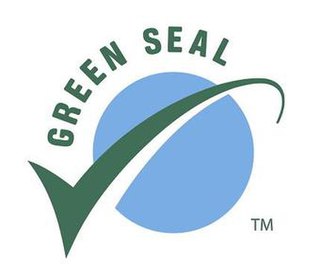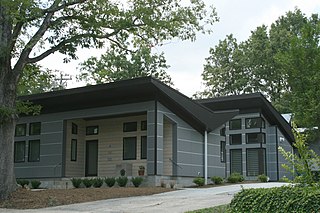
Minamata is a city located in Kumamoto Prefecture, Japan. It is on the west coast of Kyūshū and faces Amakusa islands. Minamata was established as a village in 1889, re-designated as a town in 1912 and grew into a city in 1949. As of March 2017, the city has an estimated population of 25,310 and a population density of 160 persons per km². The total area is 162.88 km².

Green building refers to both a structure and the application of processes that are environmentally responsible and resource-efficient throughout a building's life-cycle: from planning to design, construction, operation, maintenance, renovation, and demolition. This requires close cooperation of the contractor, the architects, the engineers, and the client at all project stages. The Green Building practice expands and complements the classical building design concerns of economy, utility, durability, and comfort. In doing so, the three dimensions of sustainability, i.e., planet, people and profit across the entire supply chain need to be considered.

Leadership in Energy and Environmental Design (LEED) is a green building certification program used worldwide. Developed by the non-profit U.S. Green Building Council (USGBC), it includes a set of rating systems for the design, construction, operation, and maintenance of green buildings, homes, and neighborhoods, which aims to help building owners and operators be environmentally responsible and use resources efficiently. By 2015, there were over 80,000 LEED-certified buildings and over 100,000 LEED-accredited professionals. Most LEED-certified buildings are located in major U.S. metropolises. LEED Canada has developed a separate rating system for the regulations and climate of that country.
Green marketing is the marketing of products that are presumed to be environmentally safe. It incorporates a broad range of activities, including product modification, changes to the production process, sustainable packaging, as well as modifying advertising. Yet defining green marketing is not a simple task where several meanings intersect and contradict each other; an example of this will be the existence of varying social, environmental and retail definitions attached to this term. Other similar terms used are environmental marketing and ecological marketing.

Energy engineering or Energy Systems Engineering is a broad field of engineering dealing with energy efficiency, energy services, facility management, plant engineering, environmental compliance, sustainable energy and renewable energy technologies. Energy engineering is one of the most recent engineering disciplines to emerge. Energy engineering combines knowledge from the fields of physics, math, and chemistry with economic and environmental engineering practices. Energy engineers apply their skills to increase efficiency and further develop renewable sources of energy. The main job of energy engineers is to find the most efficient and sustainable ways to operate buildings and manufacturing processes. Energy engineers audit the use of energy in those processes and suggest ways to improve the systems. This means suggesting advanced lighting, better insulation, more efficient heating and cooling properties of buildings. Although an energy engineer is concerned about obtaining and using energy in the most environmentally friendly ways, their field is not limited to strictly renewable energy like hydro, solar, biomass, or geothermal. Energy engineers are also employed by the fields of oil and natural gas extraction.
The Sustainable Forestry Initiative (SFI) is a sustainability organization operating in the U.S. and Canada that works across four pillars: standards, conservation, community, and education. SFI has two youth education initiatives: Project Learning Tree and Project Learning Tree Canada. SFI is the world's largest single forest certification standard by area. SFI is headquartered in Ottawa and Washington, D.C.

Sustainable seafood is seafood that is caught or farmed in ways that consider the long-term vitality of harvested species and the well-being of the oceans, as well as the livelihoods of fisheries-dependent communities. It was first promoted through the sustainable seafood movement which began in the 1990s. This operation highlights overfishing and environmentally destructive fishing methods. Through a number of initiatives, the movement has increased awareness and raised concerns over the way our seafood is obtained.
Green Star is a voluntary sustainability rating system for buildings in Australia. It was launched in 2003 by the Green Building Council of Australia (GBCA).

Green Seal is a non-profit environmental standard development and certification organization. Its flagship program is the certification of products and services. Certification is based on Green Seal standards, which contain performance, health, and sustainability criteria.
An eco hotel, or a green hotel, is an environmentally sustainable hotel or accommodation that has made important environmental improvements to its structure in order to minimize its impact on the natural environment. The basic definition of an eco-friendly hotel is an environmentally responsible lodging that follows the practices of green living. These hotels have to be certified green by an independent third-party or by the state they are located in. Traditionally, these hotels were mostly presented as ecolodges because of their location, often in jungles, and their design inspired by the use of traditional building methods applied by skilled local craftsmen in areas, such as Costa Rica and Indonesia.

The global headquarters for Novus International is located in St. Louis, Missouri in the US and is Platinum LEED certified, which is a designation that is offered by the United States Green Building Council. Platinum certification is available to buildings that demonstrate energy efficiency and sustainability. Prior to the new construction, Novus had two facilities in St. Louis, located 12 miles (19 km) apart; one was the administration building and the other was the research lab. The $20 million project’s scope included renovation of the existing building in St. Charles, Mo., with a large addition that includes two floors of office space, 10 research laboratories, a state-of-the-art employee- and customer-training center, fitness center, and catering cafeteria.
Green building on college campuses is the purposeful construction of buildings on college campuses that decreases resource usage in both the building process and also the future use of the building. The goal is to reduce CO2 emissions, energy use, and water use, while creating an atmosphere where students can be healthy and learn. Universities across the country are building to green standards set forth by the USGBC, United States Green Building Council. The USGBC is a non-profit organization that promotes sustainability in how buildings are designed and built. This organization created the Leadership in Energy and Environmental Design (LEED) rating system, which is a certification process that provides verification that a building is environmentally sustainable. In the United States, commercial and residential buildings account for 70 percent of the electricity use and over 38 percent of CO2 emissions. Because of these huge statistics regarding resource usage and emissions, the room for more efficient building practices is dramatic. Since college campuses are where the world's future leaders are being taught, colleges are choosing to construct new buildings to green standards in order to promote environmental stewardship to their students. Colleges across the United States have taken leading roles in the construction of green building in order to reduce resource consumption, save money in the long run, and instill the importance on environmental sustainability on their students. It is a better way to motivate new generation to live a sustainable life.

A green home is a type of house designed to be environmentally sustainable. Green homes focus on the efficient use of "energy, water, and building materials". A green home may use sustainably sourced, environmentally friendly, and/or recycled building materials. It may include sustainable energy sources such as solar or geothermal, and be sited to take maximum advantage of natural features such as sunlight and tree cover to improve energy efficiency.
LEED for Neighborhood Development (LEED-ND), where "LEED" stands for Leadership in Energy and Environmental Design, is a United States-based rating system that integrates the principles of smart growth, urbanism, and green building into a national system for neighborhood design. LEED certification provides independent, third-party verification that a development's location and design meet accepted high levels of environmentally responsible, sustainable development.
Sustainable products are those products that provide environmental, social and economic benefits while protecting public health and environment over their whole life cycle, from the extraction of raw materials until the final disposal.

Food waste recycling is a process to convert food waste into useful materials and products for achieving sustainability of the environment. Food waste is defined as all parts of food, inedible and edible, created before, during, and after food processing, production, and consumption. Greenhouse gases, especially methane can be reduced by food waste recycling. Food waste recycling can also alleviate the saturation of landfill sites in Hong Kong.
Organic food culture refers to a recent social and cultural trend in which there has been an increased interest in organic food due to the rise of media coverage on health, food safety, and environmental dangers of pesticides. This attitude considers food a central requirement for health, but it does not neglect the aesthetic or hedonistic (pleasurable) aspects of food consumption.
The National Green Building Standard (NGBS) is an ANSI-approved green building certification program, specifically focused on single-family and multi-family residential buildings, remodeling projects, and land developments.

The UNC Coastal Studies Institute is a campus used for research of the coastal environments and eco-systems, at 850 NC-345, Wanchese, in the Outer Banks of North Carolina, United States. The campus serves East Carolina University, UNC Chapel Hill, North Carolina State University, UNC Wilmington and Elizabeth City State University.
The Queen's Award for Enterprise: Sustainable Development is awarded each year on 21 April by Queen Elizabeth II, along with the other two Queen's Awards for Enterprise categories.









